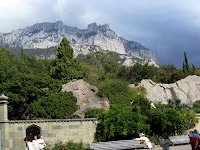




From Kaniv, burial place of Shevchenko, we sailed upstream to Kiev, the capitol, arriving on September 26. Kiev is one of the oldest cities in the world, dating back more than 1,500 years; it is sometimes called the "Mother City." The locals spell it "Kyiv," and pronounce it "Keeve." At a time London had a population of 5,000, Kiev had 25,000.
We toured the city and learned more about how Stalin treated the people of the Ukraine. During a time of good harvests, he starved to death farmers because they would not willingly give up their farms as required by Stalin's version of Communism. So Stalin took their harvests and starved to death more Ukrainians during the "Great Hunger" than the number of Jews Hitler killed. There are very few statues of Stalin left in Ukraine, but most statues of Lenin have survived.
Stalin, who had studied for the priesthood, tore down a very large number of churches in Kiev and elsewhere. One church was spared, however, because the French Ambassador went to its defense. I think that is the church in the photo at the bottom. It is a slightly smaller version of Haggia Sofia in Istanbul. Most of the destroyed churches have now been rebuilt.
The next photo up is "The Great Gate of Kiev," the inspiration for a piece in an orchestral suite entitled "Pictures At An Exhibition," by Mussorgsky. (The music was the first thing Carol thought of when we saw the gate.)
We went to the Kiev Opera House and saw the "Barber of Seville." Carol posed by the orchestra pit. The opera was very well done and was sung entirely in Ukrainian which, our hosts told us, is the second most musical language, Italian being first.
On Sunday we saw the Mormon Temple being build in Kiev, top photo. We flew home on September 28 through Moscow; with several plane changes and it took 30 hours to get home.



















